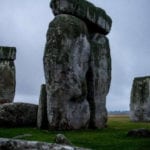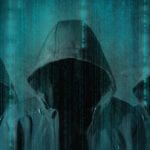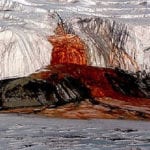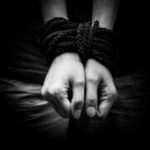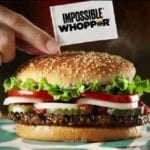 Music
Music  Music
Music  History
History 10 Less Than Jolly Events That Occurred on December 25
 Weird Stuff
Weird Stuff 10 Funny Ways That Researchers Overthink Christmas
 Politics
Politics 10 Political Scandals That Sent Crowds Into the Streets
 Weird Stuff
Weird Stuff Ten Bizarre Facts About The Doge Meme
 Our World
Our World 10 Ways Your Christmas Tree Is More Lit Than You Think
 Movies and TV
Movies and TV The 10 Coolest Stars to Set Sail on The Love Boat
 History
History 10 Things You Didn’t Know About the American National Anthem
 Technology
Technology Top 10 Everyday Tech Buzzwords That Hide a Darker Past
 Humans
Humans 10 Everyday Human Behaviors That Are Actually Survival Instincts
 Music
Music 10 Surprising Origin Stories of Your Favorite Holiday Songs
 History
History 10 Less Than Jolly Events That Occurred on December 25
 Weird Stuff
Weird Stuff 10 Funny Ways That Researchers Overthink Christmas
Who's Behind Listverse?

Jamie Frater
Head Editor
Jamie founded Listverse due to an insatiable desire to share fascinating, obscure, and bizarre facts. He has been a guest speaker on numerous national radio and television stations and is a five time published author.
More About Us Politics
Politics 10 Political Scandals That Sent Crowds Into the Streets
 Weird Stuff
Weird Stuff Ten Bizarre Facts About The Doge Meme
 Our World
Our World 10 Ways Your Christmas Tree Is More Lit Than You Think
 Movies and TV
Movies and TV The 10 Coolest Stars to Set Sail on The Love Boat
 History
History 10 Things You Didn’t Know About the American National Anthem
 Technology
Technology Top 10 Everyday Tech Buzzwords That Hide a Darker Past
 Humans
Humans 10 Everyday Human Behaviors That Are Actually Survival Instincts
10 Fascinating Mysteries Solved by Photos
This list is our second prize winner for the Listverse launch competition. Photo lists are my favorite to read and write about. I also like a good mystery. So, I thought, “What would be better than to create a list that combines the two?” This lists looks at 10 mysteries that might not have been solved without the aid of a photograph. This list was also inspired by the 1966 movie “Blow Up” starring David Hemmings, and another movie titled “Call Northside 777” made in 1948, staring Jimmy Stewart. Both are great movies and made me want to solve a crime or mystery with a photograph. I guess, in the meantime, I will have to live vicariously through the mystery solving photographs that I have collected for this list.

In 1981, Canterbury Christ Church University bought a graveyard property to build a concert hall, in Canterbury City. Before construction there were 200 remains that needed to be reinterred to make room for the hall. Among the plots in the cemetery was the famous cricketer, Fuller Pilch. However, the memorial above his plot was moved to the county cricket ground in 1978, so they had no idea where his grave was. A distant relative, Pete Pilch, 78, from Wadhurst, East Sussex, remembered a picture (shown above) of his mother standing beside the grave in the 1950s. He located it in a family album. The photograph was taken before the memorial was moved. Because of the home in the background, it provided enough information to reveal the location of the celebrated cricketer’s grave.
Interesting Fact: Canterbury Christ Church University spokeswoman told BBC News that the photograph was a huge help. The spokeswoman also added that Fuller Pilch’s grave won’t be disturbed. This is because the grave is near the front entrance to the church and the development is to be built at the back. The university may also consider some way of marking the cricketer’s grave in order to ensure the location remains in the public domain. Pilch is described as one of England’s greatest batsmen. He played for Kent from 1835 to 1854, and became famous for his unusual batting technique, known around the country as the Pilch Poke.
Discover more bizarre mysteries with Strange Planet: A compendium of weird events and nearly forgotten mysteries at Amazon.com!
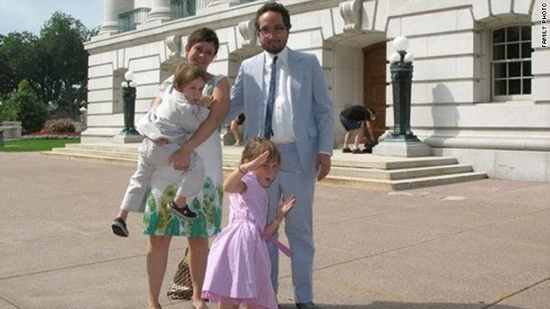
In August of 2010, John Myers and his family, from New Jersey, were in Madison, Wisconsin, to attend a friend’s wedding ceremony at the State Capitol. Myers decided to take a family portrait with his digital camera and set his bag on the statehouse steps. He set the self-timer on his camera and hustled into the frame with his wife and two children. After the picture was taken, Myers went back to retrieve his bag and found it missing. He decided to take a look at the picture he had just taken (shown above), and saw an image of someone going through his bag. Myers then took the camera to the Wisconsin Capitol Police, located inside the Capitol building. Referring to the clothing the suspect was wearing in the photo, the police were able to find him immediately, walking around with the bag he had just stolen.
Interesting Fact: John Myer told reporters: “Looking back now, it wasn’t a good idea to leave my bag so far away.” He also praised the Capitol police, saying that he expected them to just have him fill out a report, or to tell him there wasn’t much they could do, but, instead, they responded immediately and were able to catch the thief. Myers recovered all of his belongings, including his wallet and cash, his credit cards, hotel keys, rental car keys and an iPad”. Other items which had been thrown away during the heist were also found. The suspect pleaded not guilty to misdemeanor theft.

The Barack Obama “Hope” poster was designed by controversial street artist, Shepard Fairey, for the 2008 Obama presidential campaign. The image became one of the most widely recognized symbols during Obama’s run for president. The original source photograph Fairey based the poster on was always a mystery. Fairey was on record as saying that it came from a Google Image search, but couldn’t (or wouldn’t) track it back to the source. After many attempts by bloggers to find the photo, it was finally located, after the election, in January 2009. The photograph was taken, in 2006, by former Associated Press freelance photographer Mannie Garcia, during a media event with actor George Clooney, where they were raising awareness of the War in Darfur. You can see the photo here.
Interesting Fact: On February 4, 2009, the Associated Press announced that it determined “that the photograph used in the poster is an AP photo and that its use required permission.” In a press release, the AP announced that they are in discussions with Fairey’s attorney to discuss an amicable solution. Fairey’s attorney said in a press release, “We believe fair use protects Shepard’s right to do what he did here” He then filed a federal lawsuit against the Associated Press, seeking a declaratory judgment that his use of the AP photograph was protected by the fair use doctrine. In October, 2009, Fairey admitted to trying to deceive the Court by destroying evidence that he had used the photograph alleged by the AP. A property lawyer for Fairey stated that the revelation definitely put Mr. Fairey’s case “in trouble.” Earlier this year, a judge urged Fairey to settle.
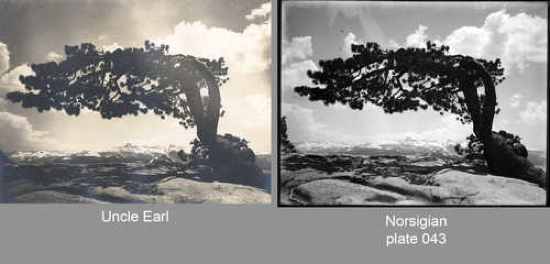
Ten years ago, Rick Norsigian made what some were calling a $200 million, find after rummaging through boxes at a garage sale. Norsigian found 65 glass negatives that some experts believed were taken by famous photographer, Ansel Adams, who is best known for his amazing black-and-white photographs of the American West. Over the following 10 years, there were many twists and turns to this story. In July, 2010, Oakland California resident Mariam Walton saw a picture of the famous Jeffrey Pine tree at Yosemite, during a television report on “famous” photographs. She immediately recognized the image as one taken by her Uncle Earl. If you look closely, you will find the clouds are different but the branches and leaves in the two photos seem to match exactly. This indicates that the two photos were, in fact, taken during the same session.
Interesting Fact: Scott Nichols, who has been studying Adams and his photography for 30 years, examined the photo by taking measurements and studying the lighting and angles of the image. Nichols said the similarities between Uncle Earl’s photo and Norsigian’s purported Adams original were striking. Nichols said: “To duplicate those shadows, to have the camera sit in the exact same place by two different photographers is virtually impossible.” Uncle Earl lived in Fresno, where the negatives were purchased, and often took photos in Yosemite. The art expert, who helped establish that a box of photo negatives from the Fresno garage sale was the lost work of Ansel Adams, recently had a change of heart about the photos.

Late last year, TMZ claimed to have uncovered a never-before published photograph that, they claimed, showed, then Senator, John F. Kennedy sunning himself on a yacht with a bunch of naked women around him. TMZ said that the photo was taken in the 1950s, and had these photos surfaced earlier, they could have “changed history”. They even brought in a forensic photo expert who compared photos of JFK to the man lounging on the deck, and concluded that the photo appeared to be authentic. Two Kennedy biographers also told TMZ that, after examining the image, they believed the man to be JFK. However, soon after the photo was published by TMZ, The Smoking Gun website discovered a color version of the same photo from a 1967 Playboy magazine photo shoot called “Chartered Yacht Party”. You can see the original color photo (may not be safe for work) here.
Interesting Fact: TMZ also reported that Jackie Kennedy was pregnant at the time, and was rushed to the hospital while JFK was on the yacht. Doctors performed an emergency C-section, but the infant was stillborn. TMZ later retracted their claims about the photo. There have been books and articles written which state that, in the summer of 1956, Kennedy spent two weeks on a boating trip in the Mediterranean. He vacationed with his brother Ted and Senator George Smathers. The three men reportedly invited several women to accompany them on their yacht. Before TMZ obtained the black and white photo it was owned by a man who kept it in a drawer for years. He would often brag to friends that he had an image of JFK on a boat with naked women. After the man died, one of his sons inherited the photo and apparently sold it to TMZ.
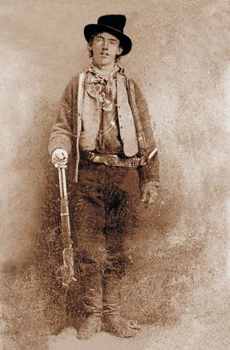
It was widely assumed during most of the 20th century that Billy the Kid was left-handed. There was even a movie made about him, staring Paul Newman. It was called “The Left Handed Gun”. This belief stemmed from the fact that the only known photographs (shown above) showed him with a Winchester rifle in his right hand and his gun on his left side. However, after experts took a good look at the photograph, it was confirmed that the outlaw’s photo was reversed and that Kid was actually right handed. A closer look shows that the buttons on Kids vest are on the left side (Men’s clothes have buttons on the right). Also, gun experts noticed that the Winchester spring plate (where the cartridges are loaded) was on the left side. Winchester produced firearms with spring plates only on the right side. You can view the corrected image here.
Interesting Fact: Billy the Kid’s real name was Henry McCarty. According to legend, he killed 21 men, one for each year of his life. However, he most likely killed fewer than half of that number. He became a legend a year after his death when the man who shot him dead, Sheriff Patrick Garrett, published a biography titled, “The Authentic Life of Billy the Kid”. He was buried in Fort Sumner’s old military cemetery, between his fallen companions Tom O’Folliard and Charlie Bowdre. Later, a single tombstone was erected over the graves (Billy’s name is his alias “William H. Bonney”) along with the word “Pals”. The tombstone has been stolen and recovered three times since it was put in place, in the 1940s. The gravesite is now enclosed in a steel cage. You can see his grave here.

After landing on the moon in February, 1971, Apollo 14 astronauts Alan Shepard and Ed Mitchell prepared to hike up to Cone Crater. Their goal was to collect samples, then make it to the lip and peer inside. The astronauts hiked uphill over 1,400 meters, dragging a tool cart full of scientific equipment (shown above). The steep incline made the going difficult, elevating the astronauts’ heart rates. Additionally, without landmarks it was difficult to judge distances. Mission Control told the astronauts to gather whatever samples they could and return. The mystery of how close they had come remained unanswered until recently. The evidence came from pictures taken by the Lunar Reconnaissance Orbiter, which was launched in 2009. The pictures showed the trail the astronauts made, and the images made clear that they were about 30 meters shy of peering into Cone Crater. You can see for yourself how close they came here.
Interesting Fact: The Lunar Reconnaissance Orbiter (LRO) is currently orbiting above the moon at 50 kilometers (31 miles). The LRO mission is preparing for future manned missions to the moon by NASA. It will provide a detailed mapping program, identify safe landing sites and locate potential resources on the moon. In addition, the LRO has provided some of the first images of equipment left over by the Apollo missions on the moon. I guess you could say this also solves a mystery for the conspiracy theorists, of whether or not man really landed on the moon. You can see other Apollo landing sites captured by the LRO here.

This photo is known as the legend of the “Wem Ghost.” The picture was taken in 1995 by Tony O’Rahilly, a farm worker and amateur photographer. O’Rahilly took the picture, while standing across the street, as a 90-year-old building in Wem, Shropshire, burned down. O’Rahilly claimed that it was only after the film was developed that the little girl appeared. Many locals said that the girl was 14-year-old Jane Churm, who accidentally started a disastrous fire in Wem, in 1677. Then, in April of 2010, a decisive piece of evidence turned up, when the local paper published an old postcard in its nostalgia section bearing a distinct likeness to the girl standing in the doorway in the photo. The girl’s dress and bonnet appear to be identical. When blown up, detail comparison confirms that this is no mere similarity; it’s an exact match down to every detail.
Interesting Fact: The technique used to produce the doctored photograph could have been similar to one used by mediums who had claimed to capture images of their dead relatives. The mediums would first ask for a photograph of the departed one, and then take a picture of it in the back room. When the client returned later for a consultation, the image would already be partially exposed on to a glass plate. Then, another picture would be taken, of the client, during the session and exposed on to the same plate. This results in showing an image of the “spirit” of their relatives. You can see the 1922 post card here and a blown up comparison here.
Have you always thought ghost hunters were crazy? You’d love Why People Believe Weird Things: Pseudoscience, Superstition, and Other Confusions of Our Time at Amazon.com!
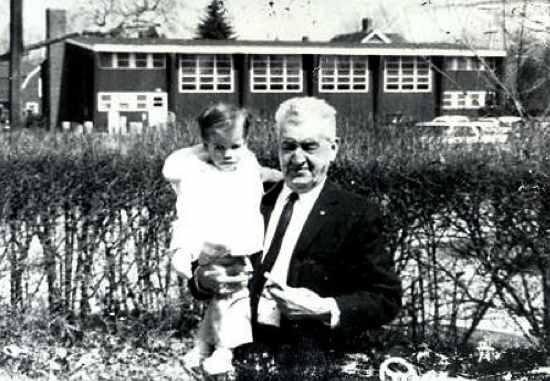
On June 13, 1993, State police in Somers, New York, found a body in the Titicus Reservoir with 38 pounds of rocks in his backpack. The man left no clues as to his name, and matched no local missing-persons reports. The only lead was a black-and-white photograph (Shown above) found on the body. The photo showed a man holding a small boy. The photograph was in a glass frame and close to his heart, under his winter clothing. Police assumed the little boy was the drowned victim, but years of investigation produced no leads. It wasn’t until 2008 (15 years later) when a retired teacher recognized the building behind the man and boy in the photograph. Investigators located the exact spot, and found that the Bookless family had a home there, before a house fire. The medical examiner’s office was then able identify the man’s name as Andrew Bookless, through his dental records.
Interesting Fact: When the Bookless family was contacted, they identified the elderly man in the picture as Andrew’s grandfather. They also said that Andrew would often disappear for months at a time, and that was part of the reason his mother did not report him missing. Police did not determine whether his death was a suicide, or whether he met with foul play. Investigators believe Andrew Bookless went through the ice in the winter of 1992-93, months before his body was found. The woman who recognized the building in the photo said, “I’m not psychic or anything like that, but I think maybe Andrew worked through me to finally get some closure.” Andrew was 31 when he died.
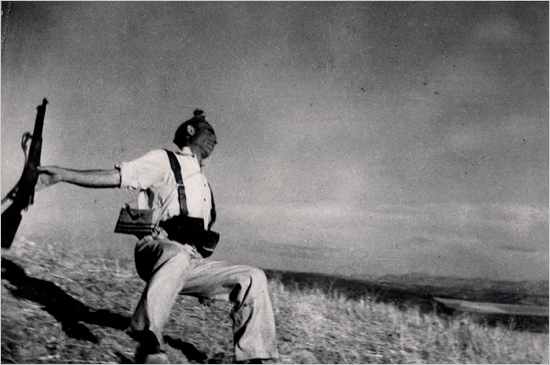
The image above is known as “The Falling Soldier” and has become universally recognized as one of the greatest war photographs ever taken. The photograph was taken by Robert Capa, in 1936, and was long thought to depict the death of a Spanish soldier during the Spanish Civil War. After years of suspicion and debate, almost all experts now agree that the photo was staged by Capa. Several other photos taken by the war photographer were taken at the same time and location as the famous photograph. One of the best examples of this appeared in a French publication, seen here. The photo at the bottom clearly shows a different soldier falling at the same time and location. Capa also claimed that the picture was taken at Cerro Muriano (where the fighting was), but detailed analysis of the falling soldier photo has proven that the action took place near Espejo.
Interesting Fact: I think most would agree that this shouldn’t take away from the outstanding work and bravery that Capa demonstrated during his great career. He was just 22 years old when he took the, now-controversial, falling soldier photo. After the Spanish Civil War, he covered and photographed the Second Sino-Japanese War. He also covered World War II, throughout Europe, including the Battle of Normandy on Omaha Beach. In 1948, Capa photographed the Arab-Israeli War. On May 25, 1954, Capa was on an assignment in Southeast Asia, where the French had been fighting for eight years in the First Indochina War. There, Capa stepped on a landmine. He was alive when help arrived, but his left leg had been blown to pieces and he had a serious wound in his chest. Capa was taken to a field hospital where he was pronounced dead on arrival. He died with his camera in his hand.
